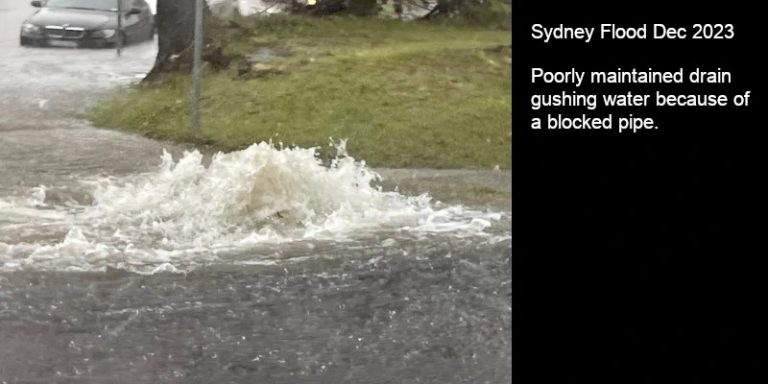Article by Eric Worrell
“…But it’s unclear how much of the significant regional increase in heavy rainfall is due to climate change, or how widespread it is…”
Landmark new study shows how global warming is affecting our rainfall
Published: July 26, 2024 6:20 AM (AEST)
Professor Steven Sherwood, Professor of Atmospheric Science, Center for Climate Change Research, University of New South Wales, Sydney
Anna Ukkola ARC DECRA Research Fellow, University of New South Wales, SydneyNew research shows that human-caused warming over the past century has increased rainfall variability over more than 75% of the Earth's land area, especially in Australia, Europe and eastern North America.
The findings by Chinese researchers and the British Met Office were published overnight in the journal Science. They provide the first systematic observational evidence that climate change is making global rainfall patterns more erratic.
Climate models predict that this change will worsen under climate change. But these new findings show that rainfall changes have worsened over the past 100 years, particularly in Australia.
…
Analysis of Australia's daily extreme rainfall totals in current and future simulations suggests that future increases are likely to be greater than anticipated by many past studies. In the most extreme events, rainfall can increase dramatically, and this appears to be the case almost everywhere on the continent.
In 2022, we used radar data to see hourly rainfall in Sydney. We found that Sydney's maximum hourly rainfall has increased by 40% over the past 20 years.
Our findings have significant implications for Sydney's preparedness for flash floods. More intense downpours could overwhelm stormwater systems designed for past conditions. But it’s unclear how much of the significant regional increase in heavy rainfall is due to climate changeor how widespread it is.
Increased variability also means a greater risk of drought. Climate models suggest rainfall variability will continue to increase in many parts of Australia unless greenhouse gas emissions are reduced rapidly.
Just a few shifts in heavy rainfall could start or end Australia's drought. This means that as dry spells become drier, even small changes in variability could lead to more damaging droughts in the future.
…
Learn more: https://theconversation.com/landmark-new-research-shows-how-global-warming-is-messing-with-our-rainfall-233432
Research on rainfall changes;
Anthropogenic amplification of precipitation changes over the past century
WENXIA ZHANG, TIANJUN ZHOU, AND PEILI WU
science
July 25, 2024
Volume 385, Issue 6707Pages 427-432
Editor's summary
As climate change continues, the warming atmosphere allows it to hold more water, producing more precipitation. A corollary of more rainfall is an amplification of precipitation variability, a behavior that is easier to predict but harder to observe. open et al.. Using global daily precipitation records shows that the expected increase in precipitation variability can actually be detected in the last century's data. This trend, most prominent in Europe, Australia and eastern North America, will make it more difficult for societies and ecosystems to adapt. ——Jesse Smith
Abstract
As the climate warms, the resulting atmospheric moisture increases extreme precipitation. Precipitation variability will also increase, producing greater wet and dry fluctuations, but this has not yet been confirmed by observations. Here we show Over the past century, global precipitation variability has increased (over 75% of the land area) due to accumulated anthropogenic warming. Variability increases from daily to intraseasonal time scales, with global daily variation increasing by 1.2% per decade, particularly in Europe, Australia, and eastern North America. The increase in precipitation variability is primarily driven by thermodynamics related to atmospheric moisture and is modulated on decadal time scales through circulation changes. Increased precipitation variability creates new challenges for weather and climate predictions and for the resilience and adaptation of societies and ecosystems.
Learn more: https://www.science.org/doi/10.1126/science.adp0212
Another reference study;
Despite uncertainty in precipitation, strong future changes in meteorological drought in CMIP6 projections
Anna M. Ukola, Martin G. de Calvay, Michael L. Roderick, Gabe Abramowitz, Andrew J. Pittman
First published: May 10, 2020Abstract
Quantifying how climate change contributes to drought is a priority to inform policy and adaptation planning. We show that the latest Coupled Model Intercomparison Project (CMIP6) simulations predict consistent regional patterns of meteorological drought through 2100 under two emission scenarios. We find strong expected changes in the duration and frequency of seasonal droughts (over 45% of global land area), although there is a lack of consistency across models in expected changes in mean precipitation (24% of land area). Future drought changes are larger and more consistent in CMIP6 than in CMIP5. We find that regional increases and decreases in drought duration and frequency are driven by changes in precipitation mean and variability. Instead, drought intensity has increased across most regions, but has not been simulated well by climate models historically. Meteorological drought predictions are more robust than average precipitation in CMIP6, providing important new opportunities for water resource planning.
Learn more: https://agupubs.onlinelibrary.wiley.com/doi/10.1029/2020GL087820
The models don't agree, but they think some of the model's predictions are reliable.
It seems like a short time to name global warming as the culprit. Not only are there other confounding factors, such as large-scale land-use changes, including greatly expanded irrigation and the emission of dust and exhaust particles, and some major volcanic eruptions such as Hunga Tonga, there is also substantial evidence that rainfall has occurred over centuries The change in scale occurred long before anthropogenic warming became a potential problem.
Perhaps when climate scientists stop making so many wrong predictions, we can experiment more with the predictions of their disturbingly divided models.
At the same time, even without forecasts of worsening flooding, local city management should invest more in drainage ditches. As I drove through the Sydney floods that day in 2023, I saw something I’ll never forget – a city worker in waist-deep floodwaters using a giant pry bar to slam into a blockage at his feet. of a large gutter, trying to pry it open. I don't understand how such dangerous emergency action would be necessary if the city did a good job of maintaining the drains before the floods hit. I certainly hope he wasn't injured that day.
related
